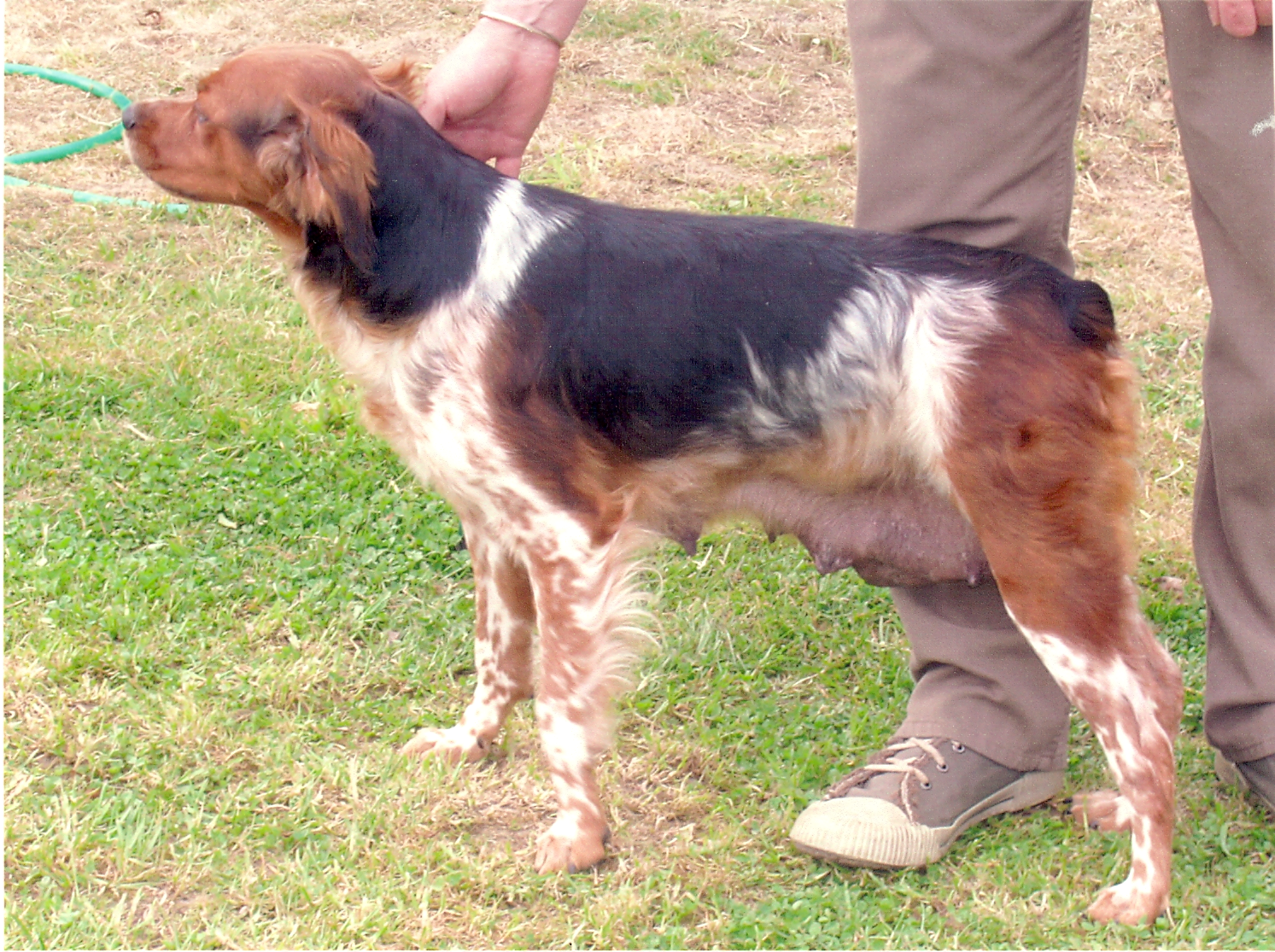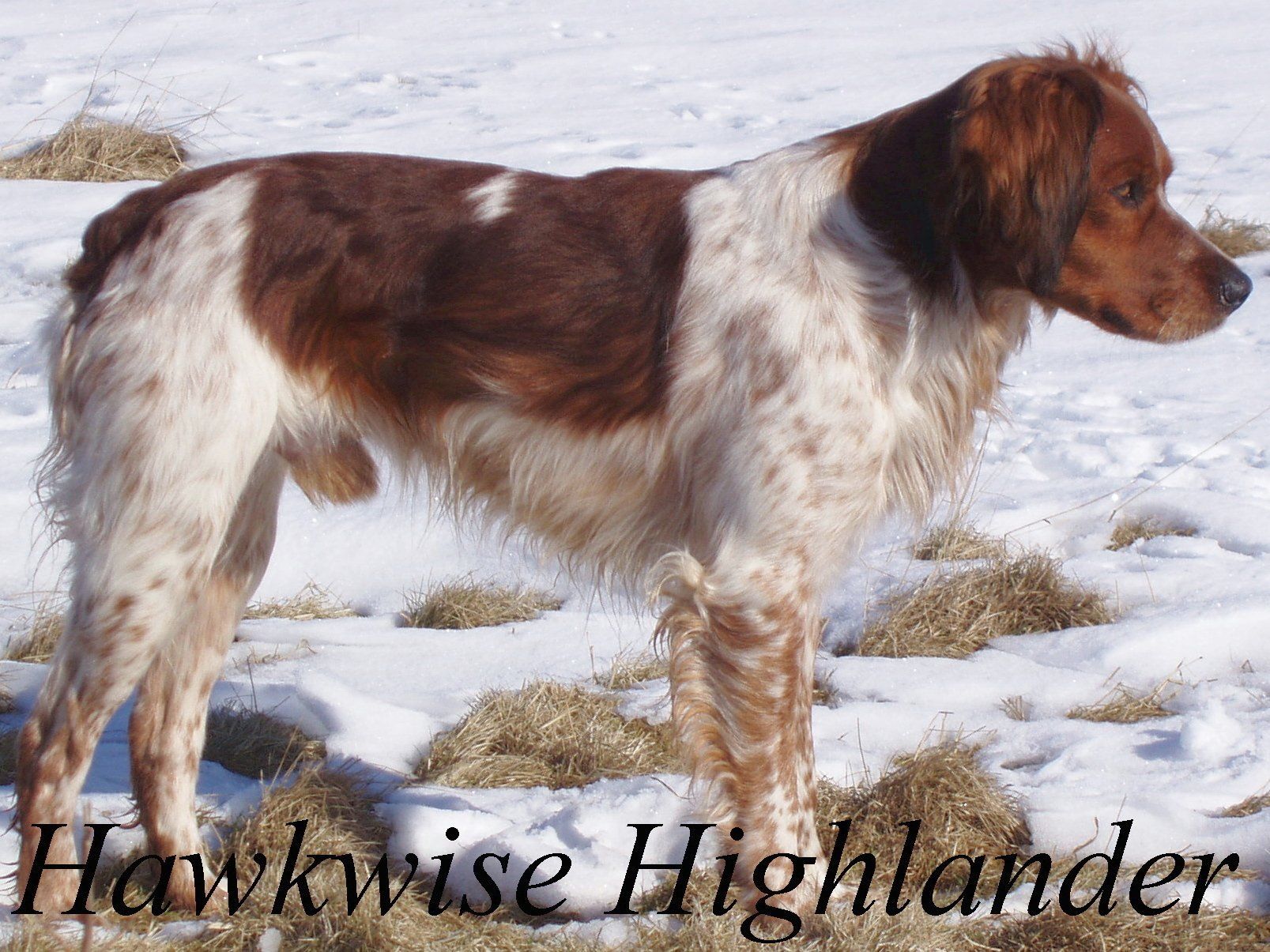HOW TO FIND OUT ABOUT HAWKWISE PUPPIES
We run a mailing list of pups bred from our Hawkwise bloodlines, usually offspring of our stud dogs or from bitches descended from our own stock. Equally we let you know of related litters that are expected in the near future. This information is emailed to you as and when litters are planned, due or have arrived (it depends on the efficiency of the bitch's owner in notifying us). Just tell us your preferred colour, sex, and what you want the dog to do. Be prepared to provide details of previous experience of Brittanys (or other breeds), reason for wanting a Brittany, family circumstances, etc. We can probably arrange for you to visit a local Brittany owner if you have never actually met the breed "in the flesh".
Contact Steve Wright on 01789 772413, 07395 094206 or email stevewright.falconer@outlook.com
A small gene pool
The different breeds of dogs were created by selecting parents for the qualities of performance and/or physique that the breeders admired. For example, if you or I decided that we wanted to produce only black dogs - then we would only mate black dogs and bitches together. Any pups that were of a different colour would be discarded. Very quickly we would achieve what we set out to do, but you might prefer long-coated dogs while I liked smoother ones. By the same process we could soon create two distinct varieties. Mating similar looking dogs together (or dogs that work in a specific way) creates what we call photo-typical dogs. Once their type becomes established they begin to breed true to it, and when this happens they are called geno-typical dogs, in that they are not able to breed anything else.
This selection process, and the necessary discarding of untypical stock, leads to a reduction in the variety of genetic options that pedigree dogs can produce when mated to a member of their own breed. Fortunately, where the desired working characteristics demand an ability to withstand the rigours of hard work, we are also selecting for robust stock. As long as this is consciously kept in mind, and not taken for granted, we can maintain a vigorous, healthy breed. However sometimes desired qualities may have a negative side to them and, if we focus on these, we sometimes can lose sight of the overall picture. Therefore breeding programmes, especially any which ignore the performance side of the breed, may concentrate and encourage weaknesses and long term vulnerability to unsoundness, loss of sight, scenting ability or hearing, etc.
Numerically small breeds, like the Brittany, will only have a small nucleus of breeding animals. It is estimated that only about 3% of all dogs are bred from. In Brittanys, with an estimated 1,700-2,000 individuals living in the UK, this means we probably have no more than 60 active breeding animals at any one time - of which possibly 12 will be males. Very often we produce less than 20 litters a year, so you can see that most stud dogs are not used very often. Very few will sire double figures of litters. This does stop excessive reliance on individual animals and helps to keep the gene pool reasonably diverse.
Some of our breeders have imported fresh stock from France and other European countries, or used overseas studs, and this is very much to their credit. However it is difficult for these breeders to know the wider families of these dogs and, without this knowledge, they could bring in as many undesirable traits as good ones. In the 1980s, when Brittanys were first brought into the UK, we also imported epilepsy and the diversity of shapes and sizes that persists today.
At Hawkwise Brittanys we have concentrated on finding and using good-looking, well-constructed working sires, often from lesser-known bloodlines and unfashionable kennels. This has kept our kennel healthy and robust, and makes our males suitable outcrosses for the more fashionable strains. One measure of our success is the percentage of our stock that are bred from. Currently it is at 6.7% - so more than twice the average. And 11 different Hawkwise dogs have been used at stud - although most of these have only served one bitch in their lives! We also monitor litter size, as this is recognised as an indicator of vigour. Over 36 years (and counting) our brood bitches have averaged over 8 pups per litter!
The gene pool further diminished
Geneticists tell us that narrowing the gene pool is not recommended, yet restricting the genetic variety of any breed is what has made it what it is. However further restrictions may always occur - either deliberately or through lack of thought.
Showing is one of the prime offenders here as it celebrates exaggeration. For example Dog A wins a lot because he has a particularly broad head, so everybody uses him at stud to improve the breadth of their own progeny's heads. The broadest of these are selected for show and are exhibited regularly. Being fashionable they win well, so this then becomes the norm when in fact it was originally an exaggeration. If this fashion continued it would be possible that future bitches might experience some of the whelping problems found in other breeds.
Extremes of other proportions or movement can change the face of the breed, and pursuing these exaggerations will narrow the genetic variety. In fact the best dog in the show ring should be the most average one! Two common breeding issues with Brittanys are colour and tails.
Breeding for colour
Most Brittanys (about 85% of them) are orange & white. This is actually a recessive version of the red chromosone, so must be present in the genes of both parents to become visible in their offspring. Peculiarly it is associated with over-riding other colours, so that a mating of two orange and white parents will only breed orange and whites - even if both have matching chromosones for other colours in their genetic make-up. In the United States, where only orange & whites and livers are permitted, this leads to an increasing deterioration of the depth of the colour, becoming 'washier' with each successive generation, and is associated with weak pigmentation. However there are other colours present in the breed. Equally as dominant as red is black and there have been black & white Brittanys since before the first recognition of the breed by the French Kennel Club. Strangely there does not seem to be any history of blue Brittanys, which would be the recessive of black just as orange is the recessive of red (a blue Brittany puppy was reportedly whelped in the USA in 2021).
Where dogs inherit both red and black chromosomes they can exhibit a range of coat patterns. Liver (the same as chocolate in Labradors) is one and is present in Brittanys. Another is tricolour where a base of black & white, or liver & white, has orange markings around the mouth, above the eyes, on the chest and lower legs and around the anus. Sometimes this distribution of colour is over a wider area and is frowned upon in the show ring.
Basically this issue has not been tackled because it is possible to avoid the sable gene by screening. This could lead to its virtual disappearance by default. In the UK the Brittany Club has not taken any action and has left it to the fashion pressures of the showring to discourage the breeding and exhibition of sables. They have recognised that they have no control over the many falconers, shooting men and pet owners who do not exhibit their Brittanys - so legislating against it would be divisive within a numerically small breed. It is a shame that they could not, instead, have recognised this attractive colour as part of the breeds inheritance, as it is not associated with any known health problems and, by accepting it, they would be extending the gene pool which is available. In France the governing body has banned sable despite the fact that it has persisted within the breed for over a century that we know of. Of course they have many thousands of Brittanys, with very varied genetics, which helps them avoid the possible pitfalls of the narrowing gene pool.
At birth all Brittany pups appear clear-marked but, within days, their little, pink pads and noses slowly start becoming darker until, at a week old, they are almost completely black. Their tummies will also start having a sprinkling of black pigmentation. The greater these areas are the more roaning will develop and, by the time they are ready for sale at around 8 weeks of age, some will already be obviously roaned. Where the pads of puppy feet remain all or partly pink the pup will have much sparser roan markings or may be entirely clear-marked, i.e. free of any 'ticking'. It may be coincidence but the clearest marked Brittany I owned had the least tolerance of nettles!
The sequence of pictures below illustrates this development.







